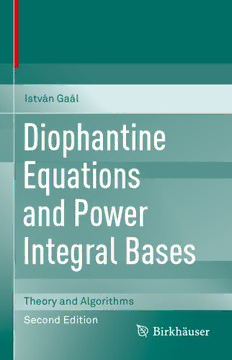Table Of ContentIstván Gaál
Diophantine
Equations
and Power
Integral Bases
Theory and Algorithms
Second Edition
Diophantine Equations and Power Integral Bases
István Gaál
Diophantine Equations
and Power Integral Bases
Theory and Algorithms
Second Edition
IstvánGaál
InstituteofMathematics
UniversityofDebrecen
Debrecen,Debrecen,Hungary
ISBN978-3-030-23864-3 ISBN978-3-030-23865-0 (eBook)
https://doi.org/10.1007/978-3-030-23865-0
MathematicsSubjectClassification:11D57,11D59,11D61,11R04,11Y50
1stedition:©BirkhäuserBoston2002
©SpringerNatureSwitzerlandAG2019
Thisworkissubjecttocopyright.AllrightsarereservedbythePublisher,whetherthewholeorpartof
thematerialisconcerned,specificallytherightsoftranslation,reprinting,reuseofillustrations,recitation,
broadcasting,reproductiononmicrofilmsorinanyotherphysicalway,andtransmissionorinformation
storageandretrieval,electronicadaptation,computersoftware,orbysimilarordissimilarmethodology
nowknownorhereafterdeveloped.
Theuseofgeneraldescriptivenames,registerednames,trademarks,servicemarks,etc.inthispublication
doesnotimply,evenintheabsenceofaspecificstatement,thatsuchnamesareexemptfromtherelevant
protectivelawsandregulationsandthereforefreeforgeneraluse.
Thepublisher,theauthors,andtheeditorsaresafetoassumethattheadviceandinformationinthisbook
arebelievedtobetrueandaccurateatthedateofpublication.Neitherthepublishernortheauthorsor
theeditorsgiveawarranty,expressorimplied,withrespecttothematerialcontainedhereinorforany
errorsoromissionsthatmayhavebeenmade.Thepublisherremainsneutralwithregardtojurisdictional
claimsinpublishedmapsandinstitutionalaffiliations.
This book is published under the imprint Birkhäuser, www.birkhauser-science.com by the registered
companySpringerNatureSwitzerlandAG.
Theregisteredcompanyaddressis:Gewerbestrasse11,6330Cham,Switzerland
ToGabi,Zsuzsi,andSzilvi
Foreword
Inthemid-1980s,theauthorstartedtoinvestigatepowerintegralbasesinalgebraic
number fields and related Diophantine equations. To construct feasible methods
requires both to develop the underlying theory of Diophantine equations and
also to create algorithms. We described relations of index form equations and
Thue equations and developed reduction and enumeration algorithms, involving
Diophantine approximation tools and LLL algorithm. Starting with cubic number
fields, within more than 10 years, we had feasible methods up to number fields
of degree 5. The first edition of this book in 2002 (Diophantine Equations and
PowerIntegralBases,NewComputationalMethods,BirkhäuserBoston,2002)was
actuallyathesisoftheauthor.
The book turned out to be useful in teaching university courses and in the
research work of interested colleagues and PhD students. And the development of
themethodsdidnotstop.Inthelast15years,wedevelopedseveralusefulmethods
onhigherdegreenumberfieldsandrelativeextensions,consideringspecificnumber
fields and also infinite parametric families of number fields.Inthis new edition of
the book, we extended the material of the first edition with a great variety of new
results,bothonthetheoryofDiophantineequationsandonthealgorithmsfortheir
resolution.Ourpurposewastoarrangealltheseresultsintoauniquecontext,togive
anup-to-dateoverviewofthisarea,andtoinspirefurtherresearch.
Debrecen,Hungary IstvánGaál
January2019
vii
Preface
Oneoftheclassicalproblemsinalgebraicnumbertheory,goingbackamongothers
toDedekind[De78],Hensel[He08],andHasse[Ha63], istodecideifanalgebraic
numberfieldK ofdegreenhasapowerintegralbasis,thatis,anintegralbasisof
type (1,α,...,αn−1). The existence of such an integral basis means that Z , the
K
ring of integers of K, is monogenic and can be generated by the single element α
over Z, that is Z = Z[α]. This problem usually leads to Diophantine equations,
K
theso-calledindexformequations.
One of the purposes of this book is to describe the structure of index form
equations and to point out their relation to other classical types of Diophantine
equationslikeThueequations.Asweshallsee,varioustypesofThueequationsplay
an essential role in the resolution of index form equations. Therefore, we provide
adetaileddiscussionoftheseequationsandsomerelatedequationslikenormform
equations,aswell.
The other aim of the book is to get acquainted with various types of number
fields. The methods for the resolution of index form equations heavily depend
on the structure of the number field they are related to. We also discuss infinite
parametric families of number fields, like the families of simplest cubic, simplest
quartic, and simplest sextic fields, pure fields of various degrees, and some other
families. The resolution of the index form equations in these parametric families
leadstoparametricindexformequations,Thueequations,etc.Hence,wearevery
muchinterestedinthesolutionsoftheseparametricfamiliesofequations.Ityields
todescribethesolutionsofinfinitelymanyDiophantineequations;hence,thisarea
promisesveryexcitingresults.
The third important purpose of this book is to describe efficient algorithms for
determining generators of power integral bases. Therefore, we provide algorithms
fortheresolutionofvarioustypesofindexformequations,relatedThueequations,
andnormformequations.Toperformthesealgorithms,oneneedscomputeralgebra
systems like Maple [CG88] and algebraic number theory packages like Kash
[DF97],Magma[BCP97],orPari[Pa].
In case we want to determine all solutions of the index form equation, i.e., all
generatorsofpowerintegralbases,thenastandardwayistoapplyBaker’smethod
ix
x Preface
combinedwithreductionmethods andenumerationmethods, oftentogetherwith
certain sieve methods. To give a rough idea, Baker’s method gives an extremely
highupperbound(e.g.,exp(1020))forthesolutions,whichimpliesthefinitenessof
thenumberofsolutionsbutnofeasiblewaytodeterminethesolutionsthemselves.
Therefore,numericalreductionmethodsareappliedtoshowthatthesolutionsarein
factunderaboundofrelativelylowmagnitude(say1000).Ifthenumberofvariables
islargerthan5or6,thenitstillyieldsahighnumberofpossiblecaseswhencewe
need some enumeration method utilizing special properties of the equation. Note
thatthereductionandenumerationmethodsarenumerical,whichgivesanexciting
experimentalaspecttotheresolutionoftheequations.
Inaddition,wedescribeseveralothermethodstocalculatethesolutionsofindex
form equations. In some cases, it is simple to exclude the existence of generators
ofpowerintegralbasesorthesolutionsofcertainDiophantineequations,byusing
special properties of the equation, by utilizing the structure of the actual number
field,orbyapplyingcongruenceconsiderations.
Animportantfeatureofthebookistoprovidethereaderwithdetailednumerical
exampleswhichgiveagoodinsightintotheapplicationofthemethods.
Itisimportanttoemphasizethatthemethodsandalgorithmswedevelopinthe
book are applicable for a wide class of related types of Diophantine equations, as
well.
The knowledge of power integral bases in a number field has important appli-
cations. The most straightforward benefit of a power integral basis is to have an
easy way of performing arithmetic calculations in Z , especially an easy way of
K
multiplication.Butithasmanyother,moreorless,independentapplications:justto
mentiononlyonequitecharacteristicapplication,letusrecalltheresultofKovács
andPetho˝ [KP91], whoprovedthatinZ ,thereexistageneralizednumbersystem
K
if and only if Z is monogenic; moreover, the generators of power integral bases
K
areneededtoconstructthesenumbersystems.
This was one of the reasons why it became interesting not only to decide the
monogenity of Z but also to determine all possible generators of power integral
K
bases.Thealgorithmfordeterminingpowerintegralbasesincubicfieldswasoneof
thefirstimportantpracticalapplicationsofthemethodsforsolvingThueequations.
The simple paper [GSch89] on this cubic case is one of the most frequently cited
papers of the author, which shows what kind of novelty such computations had at
theendofthe1980s.
It was a great challenge to try to extend the algorithms for computing all
generatorsofpowerintegralbasestohigherdegreenumberfields,whichwasfinally
successfulatleastuptodegree6ingeneralandformanyspecialhigherdegreefields
uptoaboutdegree15,wherewereachedthecapabilityofthepresentmethodsand
thelimitsofcapacityofthepresentcomputingmachinery.Imaginethatforanumber
fieldofdegreen,theindexformequationhasn−1variablesanddegreen(n−1)/2.
Thismeansthattheindexformequationismostly(alreadyinquarticfields)avery
complicatedequationthatdoesnotevenfitontooneprintedpage.
It is now about 30 years ago that the author of this book began to study
constructive methods for determining power integral bases in algebraic number
Preface xi
fields.Thematerialofthisbookwasformedbyseverallecturesheldbytheauthor
atvariousconferences(cf.[Ga91,Ga96b,Ga98b,Ga99,Ga00a]).Also,someparts
of it appeared at special university courses and PhD courses held regularly by the
author.
Thebookhasatransparentstructure.InChap.1,wefixournotation,describethe
basicconcepts,andsummarizesomeimportantresultsonpowerintegralbases.We
alsotreattherelativecase,powerintegralbasesinrelativeextensions,thatwillbe
usefulinthesequel.
In Chap.2, we collect the main tools for solving our equations. We describe
resultsonBaker’smethod,reductionmethods,andenumerationalgorithmsthatwill
beusedthroughout.
InChaps.3–5,weapplythesetoolstovarioustypesofThueequations,starting
withclassicalThueequationscontinuingwithinhomogeneousThueequationsuntil
relativeThueequations,respectively.
InChap.6,wedescribehowtoapplythesetoolstonormformequations.
Chapter7givesageneraloverviewofthestructureofindexforms.Wedetailhow
todealwithfieldshavingsubfieldsorhowmucheasiertheproblemisifthefieldis
thecompositeofitssubfields.
InChaps.8–11,wedescribethosealgorithmsthatcanbeusedforsolvingindex
form equations in cubic, quartic, quintic, and sextic number fields, respectively.
In addition to several efficient methods that work in special types of fields, we
havegeneralalgorithmsuptodegree6.Wealsoincludeseveralinfiniteparametric
familiesoffieldsandsolvethecorrespondingindexformequationsinaparametric
form.
Chapter12isdevotedtopurefields,withalotofinterestingproperties.
In Chaps.13 and 14, we consider the problem of relative power integral bases
in cubic and quartic relative extensions of fields. In Chap.15, we consider power
integralbasesinsomespecialtypesofhigherdegreenumberfields.
Finally, in Chap.16, we provide the results of our computations: tables of
solutionsofDiophantineequationsandtablesofgeneratorsofpowerintegralbases
incubic,quartic,sexticfields.Thesetablesmighthavemanyapplications.
Attheendofthechapters,thereaderwillfindnotesonfurtherresultsrelatedto
thetopicofthechapter.
The material of the book can be easily followed by graduates and even under-
graduates. We only use standard algebra and number theory contained in usual
universitycourses.BasicpropertiesofcontinuedfractionsareinthebookofNiven
and Zuckerman [NZ80]. The LLL basis reduction algorithm is detailed in Pohst
[Po93].FurtherconceptsaregiveninChaps.1and2.
StartingwiththeclassicalbookofBaker[Ba90],therearesomeothervolumes
relatedmoreorlesstosometopicsdiscussedhere,forexample,ShoreyandTijde-
man[200],deWeger[We89],Smart[Sm98],andEvertseandGyo˝ry[EGy17a].In
thepresentbook,however,weintendedtoprovideadetailedalgorithmicapproach
focusingonpowerintegralbasesandtheresolutionofindexformequations,based
xii Preface
onthemethodsforsolvingseveraltypesofThueequations,normformequations,
etc.,therefore,givingawideextensionofexistingliterature.
Debrecen,Hungary IstvánGaál
January2019

